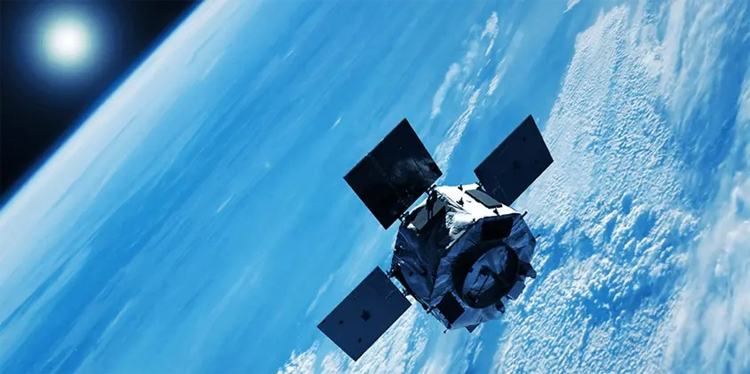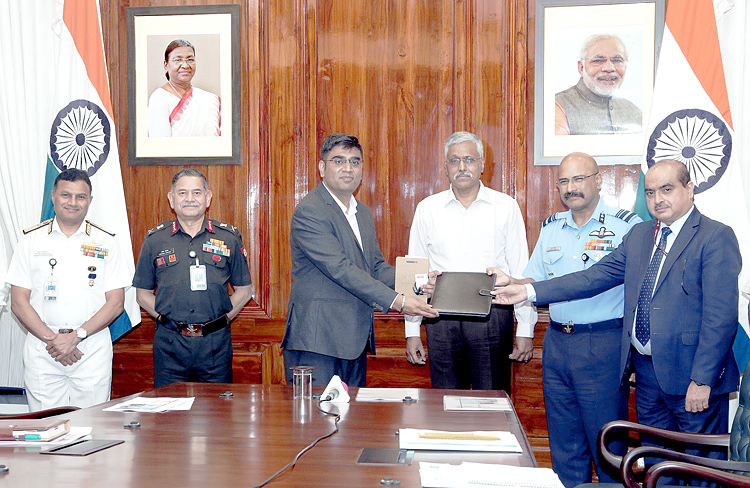INDIAN ARMED FORCES CHIEFS ON
OUR RELENTLESS AND FOCUSED PUBLISHING EFFORTS

SP Guide Publications puts forth a well compiled articulation of issues, pursuits and accomplishments of the Indian Army, over the years

I am confident that SP Guide Publications would continue to inform, inspire and influence.

My compliments to SP Guide Publications for informative and credible reportage on contemporary aerospace issues over the past six decades.
Indian Defence startups break into hyperspectral imaging small satellites in space
A breakthrough in small and advanced multi-sensor satellites opens further ground for critical hyperspectral imaging in Indian space. Smallsats have the potential to radically improve and contribute to Telecommunication by providing mobile services and Internet of Things (IoT) connectivity and purpose built for specific task (ISR) in military and civilian space.

Indian defence startup breaks into coveted areas of hyperspectral imaging. SpacePixxel Technologies and GalaxEye will design and develop a 'Miniaturised satellite capable of carrying Electro-Optical, Infrared, Synthetic Aperture Radar, and Hyperspectral payloads up to 150 kg. The development is part of a contract under the ageis of Innovations for Defence Excellence (iDEX) in the area of hyperspectral imaging satellites in space.
The breakthrough is a milestone as the miniature satellites will be the world's first advanced multi-sensors (EO+SAR) satellite, designed, built, and launched from India by domestic private players. While there will be many elements of key systems and components from outside, the capability is certainly a substantial step in broadening the space clusters to domestic private players, working on existing and futuristic space tech for the military and commercial arena.
SpacePixxel plans to launch hyperspectral imaging satellites, enabling high-resolution images which is critical for advanced mapping, Intelligence, surveillance, and reconnaissance (ISR).
The breakthrough is a milestone as the miniature satellites will be the world's first advanced multi-sensors (EO+SAR) satellite, designed, built, and launched from India by domestic private players.
The small satellites will unfold such possibilities through the efficient constellations of the small satellites which can focus with much greater details and accuracy to provide detailed earth observation data. Moreover, the smallsat has the potential to radically improve and contribute to Telecommunication by providing mobile services and Internet of Things (IoT) connectivity in military and civilian space.
In communication, small satellites facilitate global internet coverage, especially in remote and underserved regions. These satellites are instrumental in establishing IoT networks for real-time data collection from sensors on the ground, which is crucial for industries like logistics, utilities, and smart grids. In space technologies, the miniaturisation of the satellites-- small satellites -- is no small breakthrough as it further opens great new possibilities in space-based tech capabilities.
Defence applications of multi-sensor small satellites are equally diverse and critical. They enhance situational awareness on the battlefield through constant surveillance and reconnaissance. These satellites can provide critical threat assessment data to the armed forces in wartime and conflict scenarios. The versatility of multi-sensor small satellites allows for rapid reconfiguration and adaptation to new missions, making them a strategic asset in modern warfare.

The Miniature satellite and Hyperspectral challenges
Small satellites have brought new possibilities; in fact, space scientists are calling it a revolution in space tech and capabilities for the space industry. How small such a spacecraft could be? Within the existing parameters which is outlined and classified according to the ranges, it could be the size of a dish antenna to a small box.
Such innovation fuels indigenisation especially in the military domain with solutions that can be produced domestically and could bring massive tech and ISR domain advantage at much lower cost.
The greatest possibilities of small satellites are the much lower development and launch costs, rapid deployment, and most importantly, operation in large constellations. The cost is the key for the large constellations of multiple small satellites, capable for countless missions, including navigation, research, and remote sensing.
Small satellites facilitate global internet coverage, especially in remote and underserved regions, and establish IoT networks for real-time data collection from sensors on the ground.
In the world of space tech "small" is typically used to describe their mass and size. However, the current definition of smallsat or a miniature satellite is categorized as a satellite with a mass below 500 kg (1100 lb). Further, Smallsats are grouped according to their weight into the following categories: minisatellites - less than 1000 kg, microsatellite – less than 100 kg, nanosatellite – less than 10 kg, picosatellite – less than 1 kg and femtosatellite – less than 1 kg.
The breakthrough in developing mini, nano and microsatellites brings new dimensions and advantages. Primarily, the satellites which are used for remote sensing are bulky with heavier sub-systems inside and unaffordable for specific purposes. The smallsat makes it possible for specific tasks and remote sensing, making space exploration, more accessible to companies and organisations of all sizes. So, the biggest possibility of the miniature spacecraft lies in the mission-specific task and in a much shorter time due to the launch time. The specific task could be a single purpose-built and designed to operate unlike the large multi-payload spacecraft.
The development of mini, nano, and microsatellites brings new dimensions and advantages, making space exploration more accessible to companies and organizations of all sizes.
Secondly, component-wise it is radically easier to customise and fabricate such as batteries, antenna material, and radio equipment. Additionally, it can be modelled by producing custom components, for example on the 3D printer. This benefits the construction of the satellite and its payload for various technological or scientific experiments. Further advancement is taking place in limiting a number of pre-tests (testbed) and time.
However, the breakthrough is all about furthering space research due to the sheer advantages of purpose-built quick launches, reduced risk, and results. Smallsat capability will be used to test space technology that has not yet been space-tested due to the reduced overall cost risk.

LEO advantage
What adds to the perspective is the use of low LEO orbit (polar orbit type) which flies over the Earth's poles, up to 1500 km on the Earth which enables quicker deployment and experiments. Further, the LEO allows global coverage of radio communication between 98 ˚ north and 98 ˚ south latitude. In that case, a smallsat can perform radio communications in a much lower cost-effective bracket and transmissions with less power increase rechargeable batteries and the performance of photovoltaic cells with less expensive antenna systems with less weight.
AI and the future of small satellites
Now the Indian space program is also geared to embrace artificial intelligence (AI) in its various elements which show the potential of small satellites and their applications.
Recent developments show the immense possibilities in areas like data processing and automatic diagnoses based on telemetry. The very concept of fault-finding and autonomous corrections in spacecraft is itself a revolutionary process. Another groundbreaking AI application here is about the administration of constellations. With smallsat the areas of further research and gauging the potential of such satellite-provided services and spacecraft control will establish new frontier in space tech.
| Types of small satellites | ||||||||||||||||||||||||
|
Broadening space for private players
While ISRO has done it for India's Polar Satellite Launch Vehicle (PSLV), in its forty-second flight (PSLV-C40) which successfully launched the 710 kg Cartosat-2 Series Satellite for earth observation, the SpacePixxel's entry opens much wider opportunities for the private players. Additionally, it included 30 co-passenger satellites together weighing about 613 kg at lift-off.
In fact, the launch was under the commercial agreement for the 28 International customer satellites between Antrix Corporation Limited (Antrix), a Government of India company under the Department of Space (DOS), ISRO and the International customers.
ISRO with six other countries six countries -- Canada, Finland, France, South Korea, the UK, and the US —led the co-passenger satellites of one Microsatellite and one Nanosatellite from India and 3 Microsatellites and 25 Nanosatellites from six countries. The successful mission involved the combined total weight of all the 31 satellites carried onboard PSLV-C40 turns out to be 1,323 kg.
Innovations for Defence Excellence (iDEX) is fostering a burgeoning community of start-ups within the defence sector, currently engaging with over 400 start-ups and MSMEs.
Demonstrating the applications, space tech expert, Ankit Bhateja, Founder and Director, Xovian Aerospace, further explains: "Multi-sensor small satellites are a game-changer, offering cost-effective, scalable, and responsive solutions to various needs. Their potential use cases span from enhancing agricultural productivity to ensuring national security, demonstrating their indispensable role in the advancement of both civilian and defence capabilities. As technology continues to evolve, the applications of these agile spacecraft will only expand, further integrating space assets into our daily lives and strategic operations."
Importantly, as a space startup, he echoes that such Initiatives will not only help in capacity building for the domestic space sector but will also help the Indian Space startups to go global with these Indigenous developments.
iDEX's initiative
Innovations for Defence Excellence (iDEX) is the flagship initiative of the Ministry of Defence (MoD). The contract was inked with SpacePixxel Technologies. While the concept was selected last year, iDEX contract was signed and exchanged in June 2024 between Additional Secretary (Defence Production) & CEO, Defence Innovation Organisation (DIO) Anurag Bajpai and SpacePixxel and GalaxEye.
This iDEX contract enables innovation in space electronics, wherein many payloads earlier deployed on dedicated large satellites are now being miniaturised. The MoD said the modular small satellite will integrate multiple miniaturised payloads as per requirement, providing advantages like faster and economical deployment, ease of manufacturing, scalability, adaptability, and less environmental impact.
iDEX has launched 11 editions of the Defence India Start-up Challenge (DISC), and recently unveiled the Acing Development of Innovative Technologies with iDEX (ADITI) scheme to promote innovations in critical and strategic defence technologies. iDEX has successfully gained momentum, fostering a burgeoning community of start-ups within the defence sector. It is currently engaged with over 400 start-ups and MSMEs. According to the MoD, so far, procurement of 35 items, worth over ₹2,000 crore, has been cleared.
Manish Kumar Jha is a Consulting & Contributing Defence Editor for SP's Aviation, SP's Land Forces and SP's Naval Forces and a security expert. He writes on national security, military technology, strategic affairs & policies.





